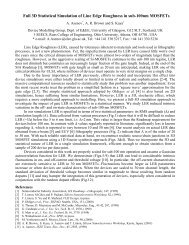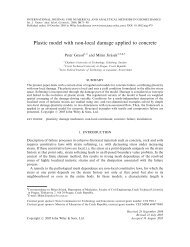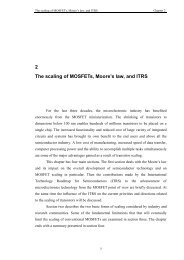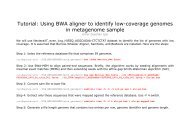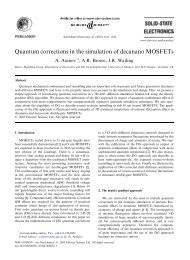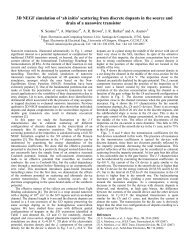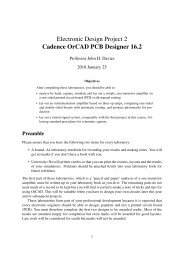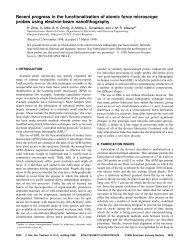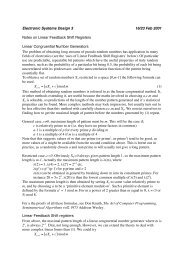Euan Trousdale REPORT
Euan Trousdale REPORT
Euan Trousdale REPORT
Create successful ePaper yourself
Turn your PDF publications into a flip-book with our unique Google optimized e-Paper software.
Production of a novel X-Aerogel for ballistics<strong>Euan</strong> <strong>Trousdale</strong>0305598Final Year Project for BEng in Mechanical Engineering3/09/08Supervisors:Dr Phil Harrison, Prof Duncan Gregory, Dr Bob Hughes
SummarySilica aerogels are essentially dried gels; the liquid that would commonly fill thepores of the gel is replaced with gas. They have extremely high pore volumes,which results in various properties which are of great interest in a variety ofapplications. They have extremely low densities, and are superb thermalinsulators. They have seen use by NASA collecting hypervelocity particles aspart of their recent Stardust project as well as insulation on the Pathfindermission’s Sojourner Mars Rover. Other applications include in Cherenkovradiation counters and there is potential for electrical applications althoughcarbon and metallic aerogels are being investigated more intensely for this.Unfortunately in their native state silica aerogels are very brittle and hydrophilicand will readily absorb moisture from the atmosphere. Once moisture isabsorbed this will result in the structural collapse of the aerogel. Recentadvances have enabled production of aerogels that are up to 300x stronger,much less hydrophilic and as a result of increased strength, will not collapseafter contact with moisture. This presents aerogels in a new light as a materialnow not only capable of absorbing massive amounts of energy in impacts andproviding effective insulation but also stable in standard atmosphericconditions. All aerogels are derived from Sol-Gel chemistry. Silica used in Sol-Gel processing is a compound of silicon and oxygen SiO 2 and is the same asthat used for making glass.By combining recently discovered techniques for creating stronger, moreatmospherically stable aerogels with glass fibre reinforcement we hoped tosynthesise aerogels displaying previously documented increases in strength aswell as increased flexibility. The aim would be to create a material optimisedfor energy absorption applications and use in ballistic armour. Problemsencountered during the production of samples resulted in them discolouring,shrinking during drying and not achieving the mechanical or atmosphericstability desired. Fibre reinforcement was hindered by uneven adhesion ofaerogel to the fibre matrix. Characterisation was only possible by SEM whichdamaged these fragile specimens and was unable to provide confirmation oneway or the other as to whether the aerogel nano-structure had survived theprocessing and ambient drying.
ContentsGlossary 3Introduction:1. Creating Silica Aerogels 52. Current Applications for Aerogels 103. Aims 124. Experimental 135. Results and Discussion 246. Conclusions 29References 30Appendix A ...............................Laboratory Planning and Risk Assessment
GlossaryA. A colloidal suspension is a substance in which one material is dispersedevenly throughout another.B. A base can be thought of as being chemically opposite to an acid and iscommonly considered as a substance that will readily accept protons.When dissolved in water they form a solution with a pH higher than 7.0and while an acid is corrosive a base is said to be caustic.C. A mesoporous material is one with pore diameters between 2 and 50nm,they have vast surface areas, which make them useful as catalysts.D. Isocyanate is the term given to a molecule that contains a functionalgroup consisting of one nitrogen, one carbon and one oxygen atomarranged: –N=C=O. Any organic compound containing this group maybe referred to as an isocyanate, if there are two of these groups they arediisocyanates.E. Carbamate, or urethane, is an amide and features the functional groupwith the structure -NH(CO)O-.F. Polyurethane is a polymer made up of organic units joined by urethanelinks. They are created in reactions between Isocyanate functional groupsand alcohol groups. A functional group is the term describing a specificgroup of atoms that provide the characteristic behaviour of a molecule.G. Polyurea is formed by a reaction with a polyamide and an isocyanatefunctional group, the resulting polymer features urea links.H. Amines are organic compounds and a type of functional group thatcontains nitrogen as the key atom. Amines are similar to ammonia, NH 3 ,but in amines the hydrogen atoms are replaced by hydrocarbon groups.Amines fall into different classes depending on how many of thehydrogen atoms have been replaced.I. Secant modulus is determined as the ratio of nominal stress tocorresponding strain at any specified point on the stress-strain curve andis expressed in force per unit area.J. Silicon is an example of a metalloid (or semi-metallic) element. There areno strictly held defining properties of metalloids, however there are somecharacteristics that are considered common to them. Metalloids oftenform amphoteric oxides (amphoteric substances are those that can react as
either an acid or a base). Metalloids often behave as semiconductors tosemi metals.K. Aldol condensation is an organic reaction in which and enolate ion reactswith a carbonyl compound. An enol is an alkene (a hydrocarbon withC=C double bond) with a hydroxyl group (-OH) joined to one of thecarbon atoms in the double bond. When the hydroxyl group in the enolloses a hydrogen ion (H + ), a negative enolate ion is formed.L. Charging is the term used to describe the accumulation of static electriccharge on the surface of the material being analysed by SEM. Charginginterferes with the image obtained and can cause scanning faults.
Introduction1. Synthesis of Silica AerogelsThe Sol-Gel process for creating silica aerogels starts with a silica precursor,such as the silica alkoxide Tetramethylorthosilicate TMOS (Fig. 1.1). This,when mixed with an alcohol such as methanol, water and a catalyst such asammonium hydroxide, will give rise to a series of hydrolysis andpolycondensation reactions forming silica particles in the solution. With thesecolloidal [a] particles dispersed in the solvent this is then referred to as the sol. Ascondensation reactions continue, depositing more silica, the particles can jointogether and form a three dimensional structure. This is then referred to as thegel. Silica aerogels are commonly produced by eitherthe one step base [b] catalyzed process or a two stepacid-base catalyzed process. Once the formation ofthe silica nano-structure is completed, there onlyremains the process of drying the gel to obtain anaerogel. If at this point the gel is left to dry throughevaporation the resulting material will be what isFig 1.1Tetramethylorthosilicate(TMOS)Molecular formula:Si(OCH 3 ) 4classed a xerogel. These are denser and have lower porosity compared toaerogels due to the collapse of the silica structure during the drying. Thiscollapse is caused by the surface tension of the solvent, as it retreats through thestructure this causes the collapse of the pores and thus shrinkage of thespecimen and increased density.The standard method for drying aerogels has for many years been the useof supercritical drying. A supercritical fluid occurs when the pressure andtemperature are above the substance’s critical point. There is no distinctionbetween liquid and gas phases, as such there is no surface tension. Asupercritical fluid can behave like a liquid and a gas simultaneously. Thisprevents the liquid-vapour meniscus, caused by the surface tension of the liquid,creating the capillary stresses that collapse the pores (1). By transforming theliquid filling the pores into a supercritical one this eliminates the liquid surfacetension and will deliver an aerogel whose mesoporous [c] structure remainsintact. An autoclave is employed to raise the temperature and pressure of thespecimen to above the critical point for the fluid in the pores. First the solventfilling the pores must be replaced by liquid CO 2 . This is called cold supercritical
drying due to the relatively low temperature, while if the gel is dried directlyafter synthesis with alcohol still in place in the pores a much higher temperatureis required and is then called hot supercritical drying. Once the CO 2 has beenremoved from the sample the process is complete. Hot Supercritical FluidExtraction (SFE) will result in aerogels that are more hydrophobic than thosedried by cold SFE due to increased presence of alkoxy groups as a result of thealcohol present during drying.Aerogel PropertiesThe native aerogels resulting from this process are very brittle (2) and sufferstructural damage if they contact moisture, to the point that ambient humiditycan affect the mechanical properties of samples (3). These native aerogels arecollections of primary particles very tightly packed together to form largersecondary particles. These are then joined to one another to form what is oftendescribed as a pearl necklace structure. When an aerogel fractures it does so atthe small interparticle ‘necks’ between thesecondary particles. The primary particles donot come apart. In order to make aerogelsstronger there must be stronger secondaryparticle ‘necks’ (4). This can be achievedsimply by making higher density aerogels,although this begins to have a detrimental impact on the unique properties of thematerial. By reinforcing only the interparticle ‘necks’ the strength can be greatlyincreased without impacting on the mesoporous structure that makes thesematerials so attractive in the first place (5). A means of providing thisreinforcement is a technique referred to a crosslinking. Crosslinking involvesattaching new material only on the surface of the silica. The surface of theaerogels are partially terminated in silanolgroups, these are compounds containing silicaatoms bonded directly to hydroxyl substituents.By reacting these surface silanols with Di-Isocyanate [d] (Fig 1.2) it has been shown thatmaterial build up will occur only on the surfaceof the secondary particles and forminterparticle tethers resulting in stronger morestable aerogels. The reaction formscarbamate [e] (urethane) groups attached to theFig 1.2 1,6-DiisocyanatohexaneMolecular FormulaOCN(CH 2 ) 6 NCOFig 1.3 The build up of crosslinkingmaterial.
surface of the gel. The interparticle linking is then formed by the Isocyanategroups, attached at one end by the carbamate, reacting with water remainingfrom the gelation, resulting in amines dangling from the surface. These thenreact with more Di-Isocyanate, this polymerisation process results in tethersbetween the aerogel particles (Fig 1.3). These tethers are partiallypolyurethane [f] and partially polyurea [g] based. Polyurea crosslinking isgenerally stronger then polyurethanes, by encouraging further polyureaformation by modifying the surface with amines [h] even stronger aerogels can beproduced (6). Surface modification of silica aerogels can be carried out duringthe first steps of the sol-gel process by co-gelation of a silica alkoxide with anamine such as 3-aminopropyltriethoxysilane (APTES) (Fig 1.4). The use ofAPTES speeds up the gelation substantiallyand removes the need for a catalyst in theprocess (7); however it can cause the reactionto occur so fast that there is no time to pour thematerial into appropriate moulds. Cooling thesolution prior to mixing in a dry ice bath hasproven useful in slowing this reaction tomanageable speeds (6).Fig 1.4. (3-Aminopropyp)triethoxysilane(APTES)Molecular formula:H 2 N(CH 2 ) 3 Si(OC 2 H 5 ) 3Crosslinking can also be provided byepoxies, using the same amine modified starting gels and a similar technique tothat used in Di-Isocyanate crosslinking these epoxy aerogels show similarincrease in mechanical properties. At very low densities the amount of silicapresent in these cross-linked aerogels means that the material can adopt certaintraits of the polymer cross-linker, to the extent that they can be made flexible(8). These epoxy and Di-Iso CSA’s are much less hydrophilic than nativeaerogels and, due to their increased strength, are less likely to suffer structuraldamage as a result of contact with moisture. That said they are not hydrophobicas they will still absorb moisture from their surroundings, albeit at a muchreduced speed. Amine surface modification has been employed along withpolystyrene crosslinking to provide aerogels not only displaying the increasedmechanical properties of previous CSA’s but adding to them hydrophobicity(9).With cross-linked silica aerogels (CSA) it has been shown to be possibleto not only rely on SFE for the final drying stage. Due to the increased strengthexhibited by these CSA it was found that if the liquid filling the pores had a low
enough surface tension then there would be little damage done by drying atambient temperatures (10). To this end the pores were filled with varioushydrocarbons. When examined using Scanning Electron Microscopy (SEM) thespecimens of low surface tension runs were seen to be very similar in structureto those produced by traditional drying methods. Higher surface tensionhydrocarbon specimens suffered from collapse of the pores as would beexpected with ambient pressure drying of native aerogels. The collapse of themicrostructure was not to the same extent as that shown in native aerogels.Materials from these higher surface tension liquids displayed higher densitiesbut not as high as xerogels which would be produced from ambient pressuredried native gels. The gels that suffered the least damage during drying werethose that used pentane. The gels had a translucent appearance with minimalshrinkage while those that suffer collapse were clear and shrunken. This processwhile successful involved many washing stages that were very time consuming.There have been other methods adopted for ambient pressure drying that avoidthe many washing stages. One such attempt involved using a cheaper source ofsilica than the standard silicon alkoxide or sodium silicate. (11). Usingwaterglass as the silica precursor to create the sol this was allowed to gel andage as with other gels. Then there was one single solvent exchange stage whichwas also a surface modification. This left the specimen with a low surfacetension hydrocarbon in the pores and a strengthened structure that could copewith ambient drying with this solvent in place. Densities of these aerogels werearound three times higher than similarly dried crosslinked samples. This showsthat strength of an aerogel can be increased simply by material addition but bycrosslinking the particles the strength can be greatly increased for a smallincrease in density.Waterglass based aerogels have been combined with aluminosilicate glassfibre matrix (12). It was shown that it was possible to create these compositematerials by simply immersing the glass wool in the gel stage. These were thendried at ambient pressure following similar solvent exchange and surfacemodification techniques as used previously. Relatively high density aerogelsresulted and thermal conductivity more in line with that of standard glass fibrewool although improvements in this area were achieved with additives to theaerogel. Most importantly these were specimens exhibited increased flexibility.Attempts to strengthen aerogels through standard fibre-reinforcementtechniques have resulted in mixed success. While some fibre-reinforced
aerogels showed reduced shrinkage during the production, this resulted in alower matrix density, both hardness and compressive strength tended todecrease with an increase in fibre reinforcement. The strain at fracture did notfollow a discernable trend with respect to percentage of fibre reinforcementincluded. Secant modulus [i] generally decreased with increasing fibrereinforcement for a given target density (13). When tested against nativeaerogels it was found that native aerogels had higher matrix density and higherstrain at fracture. In higher matrix density reinforced specimens the strain atfracture decreases with increasing fibre content while in lower matrix densityspecimens increasing fibre content actually increases the strain at fracture. Thefibre reinforcement used for that experiment was a mixture of silica, alumina(aluminium oxide) and aluminaborosilicate fibres. These were mixed into thesol with stirring at constant rate. In addition to the reinforcement the effect ofaging was investigated. After aging for 2 months the resulting aerogels hadincreased secant moduli and decreasing strain at fracture, the toughnessdecreased and they became more brittle. Other methods exist for producingflexible aerogel products such as the aerogel containing blanket (14). This canbe formed by an aqueous slurry of preformed hydrophobic aerogels, fibres andat least one drying agent. This is then compressed, dried and can be formed intoa web or a more dense structure and used in the blanket. Preferable aerogels tobe used are those derived from metal oxides such as Silicon (being ametalloid [j] ) or Aluminium compounds suitable for the sol-gel process. Alsoorganic substances such as melamine-formaldehyde condensates or resorcinolformaldehydecondensate are suitable. Hydrophobic aerogels are availablecommercially from companies such as Cabot Corporation, and are available asfine particle powders (15), as large particle beads (16) or built into some of theirother products (17). As these are preformed the desired characteristics can bechosen from those available and will be present in the final blanket. Anothermethod sees a pre-gel mixture poured into a fibrous matrix where it is allowedto gel and is then supercritically dried (18). This is then sandwiched betweenother fabric layers to produce a blanket. The aim is to produce a material withno fibre-fibre contact which would result in the aerogel insulation propertiesbeing maximised in the final product.
2. Current Applications for AerogelsGiven the various advances in the processing of aerogels in the last 10 yearsaerogels are becoming a more practical material for a variety of applications.With the emphasis in modern buildings being placed on energy efficiency, oneof the world’s most insulating solids becomes a very attractive prospect. Certaincompanies have led the way in bringing these materials to the commercialmarket. One such company that has been mentioned earlier was the CabotCorporation. Their nanogel (their name for the family of aerogels they havedeveloped) has been used throughout a range of insulating products, from theirdaylighting systems and composite structural panels to industrial pipe, LiquifiedNatural Gas (LNG) and cryogenic insulation. The daylighting systems providethe ability to get natural light into commercial, residential or public spaceswithout incurring the problems associated with trying to provide adequateinsulation in traditional glass solutions. By using nanogel systems the thermalconductivity of the panel is less than 20% that of standard gas filled insulatingglass (19). These are glazed units that have aerogels sandwiched in betweeninsulating glass (20). This avoids any structural or atmospheric problems butalso eliminates any lightweight potential in the units. The nanogel pipelineinsulation is provided by a similar technique of aerogels sandwiched betweenmaterials that provide the structural stability, in the case of the CompressionPack this material is Polyethylene which provides flexibility (21). TheirThermalwrap has been designed for use in outdoor gear such as highlyinsulating insoles for footwear. Other companies taking forward thistechnology include Aspen Aerogels who have developed highly insulatingproducts similar to Cabot’s. They too have products designed for pipelines, oiland cryogenic facilities along with outdoor gear. They also have a line of moretraditional fibre glass wool style insulation for buildings in the form of anaerogel blanket called Spaceloft Insul-Cap. These boast very low thermalconductivity thanks to the aerogel alongside the flexibility and crush resilienceof standard building insulation (22). NASA has been involved alongside AspenAerogels and awarded them a contract in the early 1990’s to develop amanufacturing process for aerogel products (23). Companies such as Dunlophave brought aerogels to the sports market in several of their rackets for squashand tennis. Endura, a cycling wear company, have produced a glove that
contains aerogel padding. It is unclear how much of the aerogels properties arebeing utilised and in what way they are working in the products. Dunlop claimsthe aerogel incorporated in their rackets gives increased stiffness and providesreduced vibration and a more solid contact with the ball (24).NASA themselves have used aerogels for many years now, in what could beviewed as the traditional role of providing insulation, albeit in extremeconditions, to the electronics of the Pathfinder mission’s Sojourner MarsRover. Most recently on the Stardust mission aerogels were used to bringhypervelocity particles from comets and interstellar dust back to earth for study(Fig2.1). In order to bring these particles, which travel at immense speeds (tensof kilometres per second),back relatively undamaged,aerogels bring them to restrelatively slowly withoutcausing them to melt. One ofthe main requirements wasthat the aerogels should havegood transparency in order tobe able to locate theimbedded particle once itwas returned, given that twostep gels provide clearer gelsthese were chosen for the mission (1). Given the use of aerogels in the stardustmission along with recent investigation of CSA’s properties at high strain rates(25) suggest that aerogelscould be very useful asFig 2.1 shows the aerogel blocks arranged on the Stardustcollector.component in future ballistic armour. Traditional mechanical testing of aerogelsis done by a three point flexural bending test (26), but this does not give insightinto the properties at high strain rates as would be experienced in ballisticarmour applications. In order to obtain suitable data the use of a SplitHopkinson Pressure Bar (SHPB) was necessary. This apparatus when used incombination with high speed photography allowed the study of modes offailure. It was found that with increasing CSA density there was increasedstiffness and improved strength, this was the case for all strain rates and stressstrainresults were independent of specimen thickness. Wet samples displayedhigher Young’s Modulus at small strains due to a reinforcing effect of the water
trapped in the pores, while these wet samples had lower yield strength due toweakening of the interparticle necks once the water had escaped from the pores.3. AimsBy combining the crosslinking process with fibre reinforcement whileemploying ambient pressure drying techniques an aerogel that is both strongatmospherically stable and flexible should be possible. This aerogel should bebetter suited to the energy absorption applications planned. Characterisation ofthis new material through both mechanical testing methods and structuralanalysis by Scanning Electron Microscopy will allow the suitability of the newaerogel for inclusion in ballistic armour to be assessed.The two methods of gel preparation, as mentioned already, are one stepbase catalysed gels and two step acid-base catalysed gels. The process forcreating one step gels is relatively quick and involves preparing two solutions;the first with the silicon alkoxide in alcohol and the second with water, alcoholand a base as a catalyst. These are mixed and once mixed the hydrolysis andpolycondensation reactions begin. The sol would then be poured intoappropriate moulds and allowed to gel. A standard two step process issubstantially more involved and begins with the silicon alkoxide being mixedwith alcohol water and an acid. This would then be refluxed for four hours withstirring as the temperature is controlled. Some of the solvent would be distilledoff until the solution reached a certain temperature and then allowed to cool toroom temperature. More silica alkoxide would then be added and furtherrefluxing for four hours before a second distillation removing more solvent.This would be cooled to room temperature and then acetonitrile added to makeup the stock solution for the gels. By mixing this then with a solution ofacetonitrile, water and a base catalyst the sol would begin reacting and gelling.The single step process is substantially less time consuming than the two stepmethod and produces generally stronger but more brittle aerogels. Two stepaerogels have a narrower pore size, tend to be clearer than one step gels and canmore easily produce gels of extremely low density (27). Given the goals of thisproject the single step process producing stronger aerogels was chosen.
4. ExperimentalMaterialsTetramethylorthosilicate (TMOS), Ammonium hydroxide (NH 4 OH) andPentane (C 5 H 12 ) were purchased from Sigma-Aldrich and used as received,Methanol (CH 3 OH), Ethanol (CH 3 CH 2 OH), deionised water, Acetone(CH 3 COCH 3 ). Desmodur N3200 was obtained courtesy of Bayer Corporation.Knauf Space Blanket Glass Fibre wool was purchased from B&Q.EquipmentThe 14ml plastic tubes used as moulds and containers for later stage washingswere approximately 1cm in diameter and 12cm long although they were taperedtowards the bottom. The crucibles used to mould later runs were approximately8cm in length 1cm deep and 1cm wide.MethodOn the 2/07/08 the first trial run was started following the one step basecatalysed process previously published (28). The hazards were identified and aRisk Assessment was written up along with a Gantt chart showing proposedlaboratory work. Along with a Gantt chart of actual work these are in AppendixA. Solution A consisted of 15.2ml TMOS and 18ml of methanol, solution B was18ml methanol, 6ml deionised water and 0.8ml ammonium hydroxide. The firstattempt at this process resulted in an accelerated gelation during the mixing ofsolutions A and B caused by the magnetic mixing plate accidentally being setup as a hot plate also. Although the heat addition to this mixing stage was briefthis was all that was required to cause gelation to occur before the sol could bepoured into the desired moulds. Quickly this gel had begun to dry out and tocrack, later to disintegrate upon attempts to remove from the beaker. The secondattempt was carried out in the same way but on a cool mixing plate so as toavoid the premature gelation. Three samples were poured in the plastic test tubestyle moulds with screw top caps, more would have been desirable but thegelation occurred mid pour of the fourth sample, indicating that the solution wasperhaps mixed for too long. These were designated 1A, 1B and 1C. The threesamples were left to age for 48 hours, after this period the samples were visuallyinspected for any indication of aging having occurred. Since there was not anyclear change in dimensions or optical properties, one of the samples was opened
and then resealed this time with parafilm with 4 holes pierced in the top. Thethree samples were then allowed to age for a further 3 days.After the 3 days again no change was apparent and it was concluded thatthere must be no visually noticeable change to be expected at this stage. Theprocedure being followed for washing the samples (10) did not stipulate theperiod for the first washing with ethanol so Sample 1B was washed with ethanolon the afternoon of the 7/07/08 for 15 mins and then with the first acetone wash.The other two samples, 1A & C, were washed in ethanol and left overnight. Thewashings were performed by fillingthe containers to the top with thesolvent and resealing samples.Once it was time to change awashing, the container would beemptied and then refilled andresealed. We hoped to see if thetime taken in the ethanol washingstage was important to laterproperties as there was no timedesignated to this step in thepublished procedure. Washingswere carried out as close the 8 hourintervals suggested in the publishedprocedure as possible and followedthe method shown in figure 4.1.Fig 4.1 Showing the process followed duringproduction.The second run was attempted in the same way as run one, except themixing time was reduced greatly to eliminate any risk of premature gelation.Mixing was carried out for approximately 15 seconds. Five samples werepoured in the same plastic tube containers as used in run one, these were 2A-E.Gelation of this run did not seem to be occurring and this was assumed to bebecause of a inadequate quantity of ammonium hydroxide catalyst in sol B.Sample 2A was tested with a direct addition of ammonium hydroxide, thiscaused an instantaneous reaction in the solution with which it contacted first.This resulted in pieces of solid white silica forming and dropping to the bottomof the sol which then gelled a while later. For the remaining samples ammoniumhydroxide was diluted with methanol and water of the same ratio as in the sol B
so as to prevent the immediate gelation as experienced with 2A. The samplesgelled and were then left to age.On the morning of the 8/07/08 sample 2A was washed with ethanol after24 hours aging to see if this reduced aging time would impact later properties.1C & A were emptied of ethanol and then given the 1 st wash in acetone, while1B was given its 2 nd acetone wash.By the 10/07/08 there had been no visual change in any of the samplesduring the acetone washing stage and run 1 samples were ready to begin thecrosslinking procedure. Iso solution made up from 50/50 weight desmodurN3200 and acetone. The two were measured on scales and then mixed on themixing plate for approximately 5 minutes for the highly viscous N3200 to mixwith the acetone completely. Run 1 sample tubes were then filled with this andleft to equilibrate for 24 hours. After this period itwas seen that the samples had become cloudy around5 mm below the Isocyanate solution contact and in Aand B the iso solution had formed a solid gel on topof the samples (Fig4.2). This cloudy discolourationthen faded further down the sample. These were thenplaced in the oven at around 52°C as prescribed bythe published procedure, for 3 days. The oven curingstage is when the crosslinking should beoccurring. On the 11/07/08, a third run wasstarted, this time moulded in square plastic dishes.Since the first two runs had shown no signs ofshrinkage and were not able to be removed fromthe containers in which they were moulded, it was of concern that this wouldnot be providing adequate access to the ethanol and acetone during washingsand the iso solution during crosslinking. By moulding in the square dishes itwas hoped it would be easy to remove the samples after gelation had occurredallowing the sample to be submerged in the washing solvent and eventually isosolution. Two samples were poured in this run, 3A and 3B, sealed with parafilmand left to age for 3 days to age.After the 3 days aging it was found that the parafilm seal on 3B was notairtight and as such the sample had dried out shrinking and forming a largecrack. It was transparent and was not susceptible to damage caused by moisturein the air; it had become a xerogel (Fig 4.3). 3A continued to the washing stagesFig 4.2 Showing the solidified (whitesections) Iso solution in A&B and thecloudy section below the surface of eachsample indicated by the arrows
undamaged. When run 1 samples were removed fromoven, the Isocyanate/acetone solution had solidifiedand formed white rubbery cylinders (Fig 4.4). Thesewere stuck to the top of the samples and removingthem took the top off the samples, the samplesthemselves had shrunk and cracked into differentpieces. The pieces that were attached to theiso/acetone began to crumble further once left in theambient conditions inside the fume hood. The samplesthen began the second washing stage. Run 2 haddeveloped a brown/orange discolouration towards thetop of the samples that faded and became clear furtherdown (Fig 4.5). These were given their isosolution wash; the same iso solution wasused as for the first run. Given the concernsabout whether or not the washing solutionwould penetrate the structure adequately, 2Bhad a fine hole put through it from top tobottom with a piece of metal wire to see if itwould help the iso/acetone solutionpenetrate the aerogel structure and result inbetter crosslinking.On the 15/07/08 after being given 24hours to equilibrate, the iso solution in run 2samples had remained clear and notsolidified. Run 2 specimens were placed inthe oven to cure. Sample 3A broke intoseveral large pieces when it was beinghandled moving into a larger beaker forwashing. It took only moments in theatmosphere for it to begin to crack and fallapart. The pieces were placed in the beakerand washings were resumed. By themorning of the 17/07/08 3A was ready forits iso wash. This was carried out in thesame way as previous runs. On the sameday run 2 was removed from the oven.Fig 4.3 3B a xerogel produced byambient drying after gelationFig 4.4 Right: the solidified iso material. Left:smaller cylinders are the top sections of thesamples that had stuck to the iso material. Thisbroke away with the iso.Fig 4.5 Samples of run 2 showing the firstsigns of brown discolouration.
Increased pressure seemed to haveforced the iso/acetone solution outfrom the sealed cylindricalcontainers. As a result the samplesdried out causing shrinkage,extensive cracking and furtherdiscolouration (Fig 4.6). They wereall much darker, yellow/brown.Run 1 was ready to begin the finalwashing stage where the acetone inthe pores is replaced with pentaneto enable ambient pressure drying.They remained relatively clear atthis stage although they had eachcracked into several pieces.4.6 run 2 in acetone wash following oven curingSample 3A was placed inthe oven to cure on the 18/07/08.The sample was inside a beakersealed with 2 layers of parafilmand left over the weekend. Whenthe sample was removed from theoven it was found that theparafilm had melted. Theiso/acetone solution had almostFig 4.7 3A after oven curing. It can be seen that theaerogel is in the highly viscous remains of the isosolution.completely dried; a small amount of highly viscous material remained (Fig 4.7).The remains began the second washing stage. Run 1 finished its pentanewashings on the same day, 22/07/08, and the samples were left open to dryunder ambient pressure at room temperature. A fourth run was started andmoulded in the same containers as run 1 and 2.Run 2 had finished its final washings on the 24/07/08 and the samples weredrained and placed in the oven at 40°C to dry at ambient pressure, this was thesame temperature at which SFE would have been carried out with liquid CO 2 .Run 1 samples that had been drying at room temperature had shrunken, becomewhite and cracked further. With this result for the first run possibly being downto the inability to remove the samples and submerge them fully in the washingsolvents and iso solution, a fifth run was started that afternoon hoping again to
produce samples capable of being removed from the moulds after gelation.These were moulded in rectangular crucibles that were lined with aluminiumfoil to make removal easy. Unlike the third run these samples would be able tobe sealed inside the screw top containers that the other samples had beenmoulded in. This would eliminate the problem of sealing during both thewashing and the oven curing phases experienced with run 3. Once the sol hadbeen poured into the moulds they were sealed with parafilm and left to age.There were two moulded in the crucibles and the remainder poured into thecylindrical containers. This was due to a lack of crucibles. Run 2 was removedfrom the oven. The specimens had shrunk during the drying process. Uponremoval from the oven they began to cloud and shrink further causing cracking.Perhaps longer in the oven drying was required or perhaps these were beingdamaged by moisture in the atmosphere, this would be a sign of unsuccessfulcrosslinking.On the 25/07/08 3A was undergoing the final washing stage. Due to asmall tear that went unnoticed in theparafilm seal, the pentane had dried out of3A and the sample had cracked extensively(Fig 4.8). Given the problems experiencedwith this sample it seemed unlikely toproduce a successful CSA and the samplewas not processed any further. The samplewas placed with the completed runs in thefume hood’s cupboard. It looked like theoven curing problem had resulted in thepieces of aerogel being imbedded in thesolidified Di-Isocyanate. This kept thecracking and brittle aerogels together to acertain extent.Fig 4.8 the remains of 3A after the prematuredrying at ambient pressure
On the 28/07/08, before washings could begin on run 5 they wereremoved from their moulds. They werecovered in ethanol to help protectagainst drying out while beingtransferred, but 5B cracked into severallarge pieces during this process. A sixthrun began on the 29/07/08; this was thefirst run to feature the use of glass fibrewool. The samples were moulded in thecylindrical screw top containers, withthe wool placed in each before the solwas poured (Fig 4.9). Given that theprevious reports of glass fibre wool(29) (12) being used in aerogels gaveno indication as to quantity being used, the cylinders were filled with the woolwith the exception of samples A and B that had the same amount as each of theothers contained split between them. When run 4 was ready for the oven cure allsamples and iso solution remained clear. The iso solution had not solidified likewith run 1. Run 4 was placed in the oven on the 30/07/08 and was monitored toprevent leakage and subsequent drying of the samples. After 24 hours theyshowed no signs of cracking or discolouration.A seventh run was started on the 31/07/08 and this was another fibreglass run but this time to be gelled in the crucibles lined with aluminium foil(Fig 4.10). This time three samples were able to be moulded in the crucibles. Onthe 1/08/08 run 5 was placed in the oven to cure and run 4 was removed, the isohad not solidified and the containers had not leaked. Run 5 was removed fromthe oven on the 5/08/08 and although noobvious signs of iso solution leakageremained (i.e. Di-Isocyanate residue onthe inside of the beaker containing thesamples) the seal may have failed as onlysmall amounts of iso solution remained inthe sample containers. Some of thesamples had shrunk and crackedextensively while others remainedrelatively undamaged. Sample 5C was onthe floor of the oven; somehow it hadFig 4.9 run 6 moulds before the sol was poured to gel.The glass fibre wool can be seen inside the moulds.Fig 4.10 run 7 moulds with fibre glass wool andaluminium foil lining prior to sol being poured
een forced out of the beaker that held the sample tubes. 5C suffered the worstdamage and had crumbled into very small pieces. All samples had discoloured.Run 7 was removed from the moulds and placed into the cylindrical tubecontainers, these were a very tight fit. During the second acetone washing stagesample 5B fell out of its container and was lost down the sink, this left 5A as theonly crucible moulded CSA attempt without glass fibre. In the final washingstages the levels of pentane left were not great enough to be able to finish everysample. As such it was necessary to decide which samples to continue with, thiswas done by observing which ones had suffered the least cracking,discolouration and shrinkage. 5A and D were taken forward while C and E wereleft in acetone. If enough pentane remained once all other runs had finished theycould be continued. During theoven cure of run 6 the samplesdiscoloured but remained intactand showed little sign ofshrinkage. Run 7 dried during theoven curing; only small amountsof iso solution remained at thebottom of two of the samples (Fig4.11). While they remainedstructurally intact, 7A and C hadshrunk more than 7B which hadgone a darker brown than theothers. Run 4 and 5 were dried together at approximately 40°C under ambientpressure. After 48 hours drying in the oven they were removed and all sampleshad shrunk. All but 5A had cracked and broken apart. Upon removal from theircontainers the surface of the samples would cover in cracks, perhaps due toatmospheric humidity (Fig 4.12). 5A did not exhibit this behaviour. It was thefirst sample since run 1 to have gone white during the drying, although only 2/3of the sample went white (Fig 4.13). The rest remained partially transparent buthad the same brown colouring as other samples.Fig 4.11 run 7 sample after oven curing. At the bottom of the tube, to the left, can be seen the remains ofthe iso solutionFig 4.12 Top: run 4 sample after drying but inside theplastic container. Bottom: the same sample once it hadbeen removed and in the atmosphere. The surface crackingclearly visible.
Fig 4.13 5A after ambient drying, at the left end the transparent brown coloured sectionsuddenly becoming solid white where the arrow indicates
Mechanical TestingPrevious research into mechanical properties of aerogels has used the ASTMD790 procedure A or BS EN ISO 178 standard to conduct the flexural testing(5). Due to the nature of the samples provided by the CSA attempts,mechanical testing by this means would be impossible. Even the largest piecesleft after drying would be far too small to be useful in this kind of testing. Uponremoval from the containers most samples would begin cracking and if notreplaced into the tubes would begin to crumble. These clearly would becompletely inappropriate for any kind of mechanical testing.Glass wool samples showed substantially reduced shrinkage and did notdisplay any obvious signs of structural degradation when removed from theircontainers. This could be simply because there were only small obvious areas ofaerogel in these samples while most was absorbed into the fibre wool matrix.Mechanical testing could conceivably be performed on these samples. If moretime had been available a mould could have been created that meet therequirements placed on specimen dimensions detailed in ISO 178.While the samples were being broken into appropriate dimensions for the SEMit was found that although most would simply crumble 5A and run 1 samplesdid not. In fact the clear section of 5A was flexible and required cutting with aknife. The white section of 5A and the run 1 sample would break into pieces butthe pieces would retain structural integrity rather than other run samples thatwould crack and break into ever small pieces.SEMThe thirteen specimens that were chosen to be analysed by Scanning ElectronMicroscope are shown in figure 4.14. The specimens chosen were those thatwere the most structurally intact and had shrunk the least. Also colour was takeninto account; an effort was made to select specimens with a wide range incolour and transparency. The aim was to be able to get a view of the differencein microstructures produced during the synthesis. Although 3B is not consideredan aerogel but rather a xerogel and was discontinued before any attempt atcrosslinking, it was chosen as it would provide an interesting contrast againstthe other aerogels. As a xerogel is just an aerogel that has collapsed duringdrying it would provide a good reference against other samples that may have at
least partially collapsed due to unsuccessful crosslinking. Some samples had tobe either broken into smaller pieces or cut to enable them to be used in theSEM. Others that had cracked and broken during drying provided adequatelysmall samples. 5A was separated into two pieces so as the clear and the whitesection could be analysed individually. Once the correct sized simples had beenobtained they were placed on the SEM tabs and entered into the XL30 ESEMelectron microscope.Fig 4.14 shown above are the samples chosen for SEM
5. Results and discussionIt has been shown to be essential that aged gels are washed with ethanol firstand not directly with acetone, as this can produce a light brown tint (28). Thistint was found to persist even after supercritical drying and was caused by abase catalysed aldol condensation [k] products derived from the acetone. It ispossible that the samples moulded in the cylindrical tube containers hadinadequate access to the ethanol wash after aging. If this was the case then thiswould mean that all subsequent washings, up until the oven curing stage, wouldhave to be considered unsuccessful also. After the oven curing most sampleshad shrunk away from the side walls allowing washing solvents better access tothe bottom of the sample. The first run to display the brown colour was run 2;this discolouration became noticeable just before the iso/acetone wash. Run 2had been troubled by extremely slow gelation in the initial stage and to correctthis additional ammonium hydroxide was added as stated in the method. Thesamples that had the most ammonium hydroxide added would later become theones displaying the darkest colouring. This would seem to confirm thecolouring as being caused by the base catalysed aldol condensation reaction, asthe higher quantities of base would further catalyse and promote this process.However some of the discolouration was first noticed occurring towards the topof the samples. It would seem unlikely that the top of these samples would havenot had adequate access to the washing solvents. Parts of the samples that wereproduced in the crucible moulds also displayed the same brown discolourationdespite them being fully submerged in the solvent during washing stages.Only run 1 samples and part of 5A did not display any brown colouring,these samples were white instead, similar to those samples produced in previousreports (10). They also did not react in the same way when removed from thesealed containers. While most samples would crack and crumble in the lab’satmospheric conditions, these did not crack and remained structurally stable forlong periods outside the sealed containers. While 5A was the only non-fibrereinforced sample capable of being fully submerged in all washings completed,run 1 followed the same procedure as several other runs that all resulted inbrittle atmospherically unstable brown samples. The split colouring of 5A couldhave been down to leakage of iso solution during the oven curing. The top thirdwas the part that was clear with brown colouring. It is possible that during theoven curing the leakage left the level of iso solution down at the point that thenshowed the change from white to brown colouring. This would have meant the
ottom section still submerged in iso solution would was crosslinked while thetop might not have been. This is supported by the different material propertiesexhibited during SEM preparation.The shape and size of moulds used during gelation was limited by laterstages needs to seal the samples. Attempts to seal beakers during the ovenduring stage with parafilm were unsuccessful. The use of a film such asDuraSeal, which can withstand higher temperature could perhaps havewithstood the conditions during the oven curing stage. Otherwise largercontainers capable of being sealed would be required to solve the problemsencountered with inadequate washing throughout the production. Better stillwould be a simple automated system that could cut the production time in halfby allowing the washings to be constantly changed. Instead of two washings aday the intended four could be achieved with no need for personnel to bepresent. This could also provide a more effective washing and could reduce andeven eliminate the discolouration and allow better quality aerogels to beproduced. There would still be a need for better containers during the isosolution washing and oven curing.The results of the SEM analysis are given in Figure 5.1 and 5.2. The SEMwould usually be set at 20kV to provide a good quality image, this however wasdamaging the samples and preventing any image being obtained. In order to getany pictures it was necessary to reduce the setting to 2kV, this made imagingmore difficult but did not cause as much damage. Being set at a lower voltagereduces the potential resolution. As can be seen in image A even at this levelthere was still considerable damage being done to certain samples. At theselevels of magnification, detailed at the bottom of each image, it is unclear as towhether the samples have retained any porosity or if the nano-particle structurehas been destroyed by pore collapse during drying. Attempts to increasemagnification resulted in unclear images that were of little analytical use. Thiswas due to the low setting of 2kV on the SEM and charging [L] . Sample 2Bshows the most promising structure at this level of zoom, although it should bestated that this was a small seam in the sample and the rest was more similar to1C and 4F. Sample 5A gives the impression of an uneven surface, similar thatshown in the image of 2B, beneath an outer coating. The images taken fromsample 6E show that although some material did adhere to the glass fibre matrixit was non-uniform throughout the sample, some areas did not show any signsof aerogel accumulation and seemed more like unaltered glass wool. Given
more time to carry out more runs and more SEM analysis better results mayhave been obtained and observed. It may have been possible to coat the samplesbeing used in an electrically conductive material such as gold to reducecharging and obtain better results in SEM.Fig 5.1 SEM various samples, A, B and C all show the clear section of sample 5A. A shows the damage doneto the sample by the SEM, the two squares are a result of attempts to look closer at the sample. D Showssample 1C. E shows sample 2B and F shows 4F.
Fig 5.2 Both G and H are from the same sample, 6E. The top image showing aerogelmaterial attached throughout the fibre matrix, while the bottom, taken from the samesample, shows no signs of aerogel.
PricingBased on the findings published previously, samples should be expectedto only shrink by a couple of percent at the most, even during ambient pressuredrying. Taking the quantities of materials used during the experimentalprocedure and assuming that it would possible to obtain samples that wouldshrink at the most by 2-3% an evaluation of price per centimetre cubed wascarried out. The average sample run produced 6 samples of around 7cm inlength and 1 cm in diameter. This gives each sample a volume of approximately5.498cm 3 . Below are the quantities of materials required to produce eachindividual sample and their cost. The quantities stated for the washing solventsare not those used in this attempt due to the size of the containers not beinglarge enough, these would be the desired quantities for future attempts withappropriate equipment.Material Quantity Cost (£)Tetramethylorthosilicate 2.6ml 0.47Methanol 6ml 0.06Ammonium Hydroxide 0.1333ml 0.003Ethanol 20ml 0.25Acetone 168.21ml 2.71N3200 Di-isocyanate 13.3g 0.07Pentane 80ml 1.45Total £5.04This is the total price per sample, of average volume 5.498cm 3. That gives aprice per unit volume of £0.92/cm 3 .
6. ConclusionsWith better suited equipment for sealing and storing aerogel samples during thelong production process there should be better results and hopefully CSAsamples capable of mechanical testing. Improved containers would potentiallyallow better pore penetration during the washing stages and allow the diisocyanatesolution to diffuse through the gel better. This could provide formore effective crosslinking between the secondary particles of the aerogelstructure, making it less likely that the damage witnessed during ambientpressure drying would be repeated. The lack of conformity within the glass fibresamples suggest that more runs are necessary to achieve an even dispersal ofaerogel throughout the fibre matrix. The discolouration would suggest that itwould benefit in the same way as standard CSA’s from better access to washingsolvents that would result from better equipment. The time consuming washingstages themselves would in future be replaced with an automated processconstantly changing the washing solvents. This would not only reduce the timetaken to produce the samples but might also result in a more effective washingwhich could produce better quality specimens. With more time to analyse thesamples produced it would be possible to gain a better idea as to what may havefailed during the production process. By investigating what coatings could beapplied to the surface a better image could result from the SEM analysis.Without the ability to get a closer look (in the region of 100-400nm) it is notpossible to comment on the nano-structure of the specimens and thereforeevaluate how successful the overall attempt has been.
References !"#$#%! !"#$#%! !" #$ % & ' &""! !"$ ( % & ') #!" #* +,-. */ !) (# , ' !"#$#%!#! 0 !) %1!* +,-( # ' ' " $ %& '$ ! '* +,-. *( $ / ' " (&#'$ ) # ' ' * +,- / ( * . 2 * +,-#!) (( , ' ' "#! #!" ! $ () ,#$ !" #$)$*#*%+*, " + !* ' "#!&""! " ) 0) #0) ' "#!$*#*- ! ) 0* !"#$#%!
% ! 1% ,-../.0-1012. $(""# +# #("#*,%"!"/0 #1""2334 4 4 *5"** 3*4 !3%*"!3(6$7893:::;8-(3



